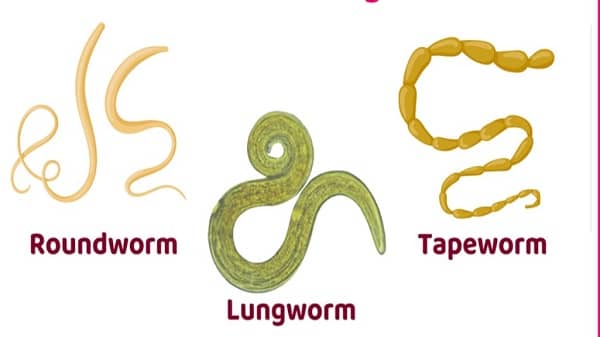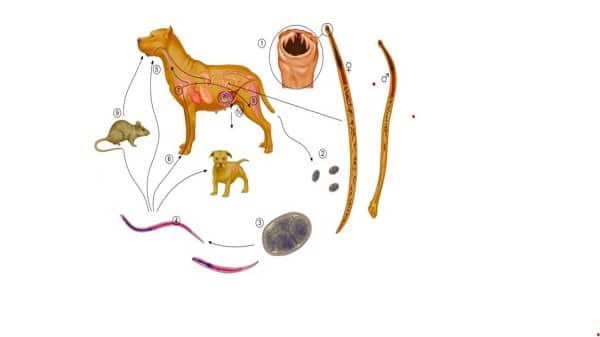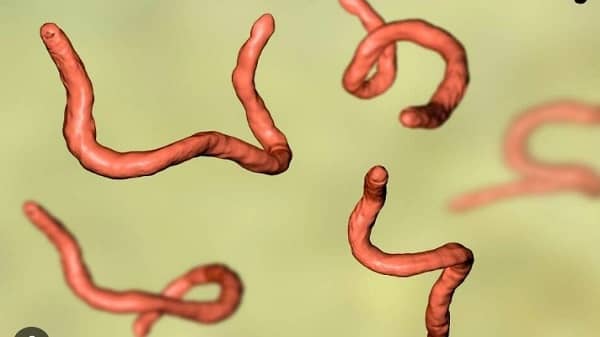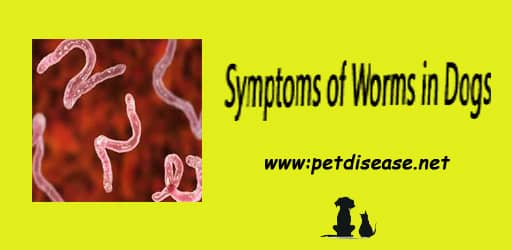Worm infestations are a common health concern for dogs, and it’s vital for pet owners to be aware of the symptoms associated with these parasites. Worms are common parasites that can be found in dogs of all ages and breeds. This article will provide valuable insights into the symptoms of various types of worms that can affect dogs. We’ll explore symptoms of worms in dogs how to identify them, and the necessary steps to treat and prevent these infestations.
How do dogs get worms?
Dogs can acquire worms through various routes, including:
- Ingesting worm eggs or larvae present in contaminated soil, water, or feces.
- Consuming infected prey or raw meat.
- Transference from an infected mother dog to her puppies during birth or through nursing.
Understanding the sources of worm infestation helps pet owners take preventive measures to protect their dogs.

The most common types of worms that affect dogs include roundworms, tapeworms, hookworms, and whipworms. Additionally, heartworms are a serious concern and are transmitted through mosquito bites.
Identifying dog worms
Dog owners may come across worms in their pet’s stool or vomit. While some worms are visible to the naked eye, others may require microscopic examination of a dog’s stool or blood. However, there are certain signs and symptoms that can help dog owners detect the presence of worms:
- Changes in appetite and weight loss: Infected dogs may experience a sudden decrease in appetite, resulting in weight loss.
- Diarrhea or vomiting: Worm infestations can lead to digestive issues such as diarrhea or vomiting. In some cases, worms may be visible in the stool or vomit.
- Visible Symptoms of Worms in Dogs: Tapeworms, for instance, may appear as small white or yellow segments that resemble grains of rice in the dog’s feces or around the anal area.
- Swollen abdomen: Some worms can cause the dog’s abdomen to appear bloated or distended.
- Anemia and weakness: Hookworms, which feed on the dog’s blood, can cause anemia, resulting in weakness, pale gums, and lethargy.
- Dull or dry coat: Dogs with worm infestations may have a lackluster coat that appears dry, brittle, or unkempt.
- Itching and irritation: Some dogs may experience itching around the anal area, leading to scooting or excessive licking.
Symptoms of heartworms in dogs
Heartworm disease is a potentially life-threatening condition caused by the parasitic worm Dirofilaria Immitis.Common symptoms of heartworm infestation include:
- Coughing: Persistent and dry coughing is often an early symptom of heartworm infestation that gets worse with exercise.
- Difficulty Breathing: Dogs may experience shortness of breath, rapid or labored breathing, and exercise intolerance.

- Lethargy: Infected dogs often show decreased energy levels and overall lethargy.
- Weight Loss: Unexplained weight loss or a failure to gain weight despite a healthy appetite can be indicative of heartworm disease.
- Reduced Appetite: Dogs may exhibit a decrease in appetite or have difficultymaintaining a healthy appetite.
- Swollen Abdomen: In advanced cases, dogs may develop a distended or swollen abdomen due to fluid accumulation.
Signs of giardia in dogs
Giardia is a microscopic parasite that can infect the intestines of dogs. Symptoms of giardia in dogs can vary, but common signs include:
- Diarrhea: Dogs with giardia may experience diarrhea, which can be watery, loose, and foul-smelling.
- Vomiting: Some infected dogs may vomit, often alongside diarrhea.
- Weight Loss: Chronic giardia infections can lead to weight loss despite a normal or increased appetite.
- Lethargy: Infected dogs may appear tired, weak, and less active than usual.
- Excess Foul–smelling Gas: Giardia infections can lead to excessive gas production,resulting in foul-smelling flatulence.
- Poor Coat Condition: Dogs with giardia may exhibit a dull and unhealthy-looking coat.
Symptoms of Tapeworms in Dogs
Tapeworms are intestinal parasites that commonly infect dogs. While some tapeworm infestations may not exhibit noticeable symptoms, there are a few indicators to look out for:
- Visible Worm Segments: Tapeworm segments are often visible in the dog’s feces or around the anal area, resembling small, white, rice-like segments.

- Itching and Irritation: Dogs may experience itching and irritation around the anal area, leading to scooting or excessive licking.
- Weight Loss: In severe cases of tapeworm infestation, dogs may experience weight loss or poor weight gain despite a healthy appetite.
Symptoms of Hookworms in Dogs
Hookworms are blood-sucking parasites that can cause severe health issues in dogs. Common symptoms of hookworm infestations include:
- Dark or Bloody Stool: Dogs with hookworms may pass dark or bloody stools, often accompanied by diarrhea.
- Anemia: Chronic hookworm infestations can lead to anemia, resulting in weakness, pale gums, and fatigue.
- Poor Growth in Puppies: Puppies with hookworms may exhibit stunted growth and fail to thrive.
- Lethargy: Dogs infected with hookworms may appear lethargic and less active.
Symptoms of Ringworm in Dogs
Contrary to its name, ringworm is not caused by worms but rather a fungal infection. Symptoms of ringworm in dogs may include:
- Circular Patches of Hair Loss: Infected dogs may develop round or oval patches of hair loss, often with a red and scaly appearance.
- Itching and Irritation: Ringworm infections can cause intense itching, leading to scratching and discomfort.
- Crusty or Inflamed Skin: Affected areas may have crusty or inflamed skin, sometimes with small pustules.
- Brittle or Broken Hair: Hair around the infected area may become brittle, break easily, or fall out.
Treatments for Worm Infestations
If you suspect your dog has worms, it is important to consult a veterinarian for an accurate diagnosis and appropriate treatment. Veterinarians may recommend fecal examinations to identify the type of worms present and prescribe suitable deworming medications.

Preventative measures, such as regular deworming and maintaining a clean living environment, are also essential to minimize the risk of re-infestation.
Prevention is Key
Preventing worm infestations in dogs is crucial for their overall health. Here are some preventative measures you can take:
- Maintain a clean living environment: Regularly clean and disinfect your dog’s bedding,living area, and litter boxes.
- Practice good hygiene: Wash your hands thoroughly after handling your dog,especially after cleaning up their feces to avoid worms in dogs.
- Keep your dog’s environment parasite-free: Use flea and tick preventatives to minimize the risk of infestation avoid getting them infected with worms.
- Regular veterinary checkups: Schedule routine veterinary examinations to monitor your dog’s health and detect any potential issues early on.
Final thoughts
Awareness of the symptoms of worms in dogs is vital for timely detection and treatment. Observing digestive issues, visible worms, poor coat condition, lethargy, a potbellied appearance, and respiratory symptoms can indicate the presence of worms. Seeking veterinary care, administering prescribed medications, and implementing preventive measures are essential for maintaining your dog’s health and preventing future infestations. Remember to consult a veterinarian for an accurate diagnosis and appropriate treatment plan.

